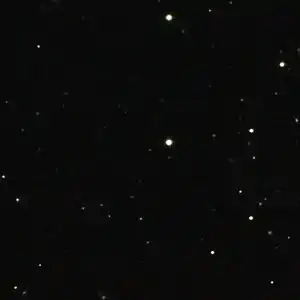ULAS J1120+0641
ULAS J1120+0641 သည် အဝေးဆုံးမှ ကွေဆာ တစ်ခုဖြစ်ပြီး ယှဉ်တွဲအကွာဝေးမှာ အလင်းနှစ် ၂၈.၈၅ ဘီလီယံရှိသည်။ ယင်းသည် အနီရောင်အရွေ့ ကျော်သည့် ပထမဆုံးကွေဆာလည်း ဖြစ်သည်။[3] ယင်းအား ၂၀၁၁ ခုနှစ်တွင် ရှာဖွေတွေ့ရှိခဲ့သည်။[1] [note 1]
| ULAS J1120+0641 | |
|---|---|
 ကွေဆာသည် အလယ်ဗဟို၌ အနီစက်အဖြစ်ပေါ်လာသည်။ | |
| လေ့လာရေးဒေတာ (Epoch J2000.0) | |
| ကြယ်စုတန်း | Leo |
| ညာဘက်တိမ်းစောင့်မှု | 11° 20′ 01.48″ |
| နိမ့်ဆင်းမှု | +06° 41′ 24.3″ |
| အနီရောင်အရွေ့ | 7.085±0.003[1] |
| အကွာအဝေး | ၂၈.၈၅ Gly (၈.၈၅ Gpc) (ယှဉ်တွဲအကွာအဝေး) [2] ၁၂.၉ Gly (၄.၀ Gpc) (အလင်းဖြတ်သန်းချိန် |
| အခြားအမည်နာမများ | |
| ULAS J112001.48+064124.3,[1] ULAS J1120+0641 | |
| အခြားကြည့်ရန်: ကွေဆာ, ကွေဆာများစာရင်း | |
မှတ်စု
ကိုးကား
- Daniel J. Mortlock (2011). "A luminous quasar at a redshift of z = 7.085". Nature 474: 616–619. doi:. PMID 21720366. Bibcode: 2011Natur.474..616M.
- Wright၊ Ned။ Ned Wright's Javascript Cosmology Calculator။ 1 July 2011 တွင် ပြန်စစ်ပြီး။
- Steve Warren (May 2011). "Photometry of the z=7.08 quasar ULAS J1120+0641". Spitzer Proposals 80114. Bibcode: 2011sptz.prop80114W.
- Jackson၊ Nicholas။ "Early Quasar Is Brightest Object Ever Found in the Universe"၊ 30 June 2011။ 30 June 2011 တွင် ပြန်စစ်ပြီး။ "ULAS J1120+0641 took the brightest object title from another quasar that wasn't formed until about 100 million years later, when the universe was 870 million years old."
- "An Observational Determination of the Bolometric Quasar Luminosity Function" (2007). The Astrophysical Journal 654 (2): 731–753. doi:. Bibcode: 2007ApJ...654..731H.
This article is issued from Wikipedia. The text is licensed under Creative Commons - Attribution - Sharealike. Additional terms may apply for the media files.